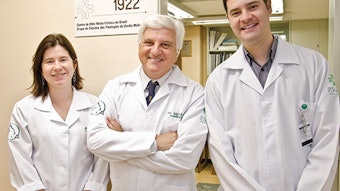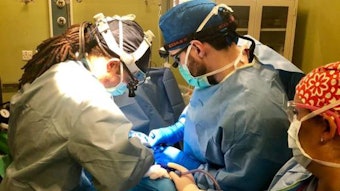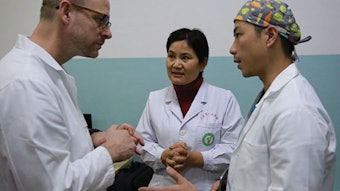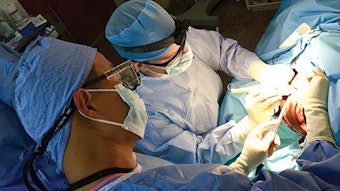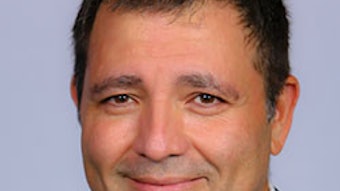Q&A
World Voice Day is Tuesday, April 16, and serves as a reminder to take care of a tool we often take for granted: our voices. In recognition of this, Voice Committee members provide in-depth answers to commonly asked questions regarding our top method of communication. Featuring questions by Lyndsay Leigh Madden, DO, with answers by Lesley F. Childs, MD; Melissa M. Mortensen, MD; Sid Khosla, MD; and Elizabeth Guardiani, MD

World Voice Day is Tuesday, April 16, and serves as a reminder to take care of a tool we often take for granted: our voices. In recognition of this, Voice Committee members provide in-depth answers to commonly asked questions regarding our top method of communication.
Featuring questions by Lyndsay Leigh Madden, DO, with answers by Lesley F. Childs, MD; Melissa M. Mortensen, MD; Sid Khosla, MD; and Elizabeth Guardiani, MD
How can voice therapy help my voice disorder?
Hapner: Voice therapy conducted by a licensed and certified speech-language pathologist has demonstrated that it is an effective treatment for many voice disorders across the lifespan. In some cases, it is used in conjunction with surgical treatments by an otolaryngologist, and in some cases it is the primary treatment for the voice disorders. For example, in the case of vocal nodules, voice therapy is often able to completely resolve the lesions. In the case of other vocal fold lesions that are often found in people with high vocal demand occupations or people who use their voices in very exuberant styles (sports enthusiasts or people who often socialize in very loud situations), voice therapy may be attempted first to see if the changes in vocal use and behaviors can result in a voice that is completely functional. In some cases, though, the vocal fold lesions may require surgery. Research has shown that voice therapy before and after surgery can often improve the overall voice outcome in people with vocal fold polyps and cysts above and beyond surgery alone.

Voice therapy has been used as the primary treatment for age-related changes to the voice. Just like changes we all experience in our muscular strength and flexibility as we age, changes in the voice accompany aging. There are specific therapy techniques that work to improve vocal strength and endurance and even reduce pain and coughing.
Speaking of chronic coughing, this troublesome problem that can go on for months and years is one of the voice disorders that is best treated with voice therapy. If the otolaryngologist is satisfied that there are no medical concerns causing the chronic cough, voice therapy, often called upper airway therapy or respiratory retraining, has demonstrated that cough replacement techniques and methods to reduce the chronic irritation to the vocal folds that often accompany cough are the primary treatment for chronic cough and chronic throat clearing.
What should you expect from voice therapy? Generally, voice therapy is conducted two to four times a month for one to two months to effect positive changes to the voice. The exact type of exercises is determined by the cause of the voice problem, and one size does not fit all. A certified and licensed speech-language pathologist will work with your physician to understand the changes to all the systems that impact the voice (like breathing and resonance) and develop an individualized program to address the particular problem causing the voice disorder. To find a certified and licensed speech-language pathologist near you who specializes in voice and upper airway disorders, go to www.asha.org/proserv. You can read more about voice therapy on the AAO-HNSF’s new patient website, ENTheath.org at https://www.enthealth.org/be_ent_smart/voice-therapy-faqs/.
I was diagnosed with reflux at the urgent care when I was seen for a hoarse voice. I am now taking anti-reflux medication. So why am I still hoarse?
Childs: Reflux is commonly treated with medication when someone presents to a primary care provider with a hoarse voice. However, there are many other causes of hoarseness. In the setting of persistent voice changes, it is important to get a laryngeal exam in order to visualize the voice box. Laryngeal examinations are performed either through the nose or mouth by an otolaryngologist or laryngologist. The laryngeal exam will reveal any abnormalities that may be responsible for a voice change, including vocal cord weakness, abnormal growths on the vocal cords, or a maladaptive muscle memory pattern used when speaking. Remember that a laryngeal exam is important in the setting of persistent voice changes, especially when there is no response to initial treatment from a primary care provider.
I had thyroid surgery and now my vocal fold is paralyzed. Is there anything new to help with this problem?
Mortensen: Over the past 30 years, the rates of thyroid surgery have tripled in the United States, according to recent estimates. The goals of thyroid surgery are to remove abnormal thyroid tissue and any involved lymph nodes, preserve parathyroid gland function, and maintain or improve voice and swallowing. In some cases, however, unintended consequences after these procedures can reduce quality of life. Research indicates that voice disturbances occur at least temporarily in up to 80 percent of patients after they undergo thyroid surgery. About 10 percent of patients experience voice disturbance directly due to (usually) temporary and (rarely) permanent laryngeal nerve injuries after surgery, with some experiencing voice problems that last for a long time after the procedure. These voice problems include breathiness with loss of air during vocalization, change in pitch, inability to project the voice, and early vocal fatigue, any and all of which can impair communication. If hoarseness persists for more than two weeks after thyroid surgery, the patient should undergo a voice evaluation. The vocal fold may be temporarily (most usual) or permanently paralyzed (more rare). The treatment of vocal fold paralysis depends on the severity of symptoms, time from injury, and the voice needs of the patient. Some patients do well without surgical treatment, so the surgeon may delay any permanent surgical intervention until a year after the initial injury to the vocal fold.
A noninvasive option for treatment is voice therapy. Voice therapy is performed with a speech and language pathologist and involves exercises or other activities to strengthen the vocal folds, improve breath control during speech, prevent abnormal tension in other muscles around the paralyzed vocal fold, and protect the airway during swallowing. Occasionally, voice therapy may be the only treatment a patient may need if the vocal folds were paralyzed in a location that does not require additional bulk or repositioning.
If the vocal fold movement or voice does not recover or the patient has high vocal demands, a surgical intervention may be performed for voice and swallowing improvement. The most common is an injection laryngoplasty or bulking procedure to the vocal fold. A bulking procedure is where a laryngologist injects a bulking agent such as body fat, collagen, hyaluronic acid, or another approved filler into the vocal fold to help medialize the vocal fold. This allows the other mobile vocal fold to make closer contact to the paralyzed fold, thereby improving voice, swallowing, and/or cough. The bulking of the vocal fold may be the only intervention needed if done within three months of the initial paralysis.
If the paralysis has lasted longer or if there is a clear indication that vocal fold motion is not going to return, then there are several permanent options. The first is a structural implant placed into the larynx. Instead of using a bulk injection, this procedure known as thyroplasty, medialization laryngoplasty or laryngeal framework surgery relies on the use of an implant in the larynx to reposition the vocal fold into the correct position to improve voice. This procedure is sometimes performed in conjunction with an arytenoid adduction. The arytenoid adduction helps position the posterior portion of the vocal fold into the correct position for vocalization.
Another permanent surgery is reinnervation. In this surgery, a healthy nerve is moved from a different area of the neck to replace the damaged nerve of the vocal fold. It can take as long as six to nine months before the voice improves. Some doctors combine this surgery with a bulk injection.
When I use my voice heavily, I become hoarse but then my voice gets better. Is this normal?
Khosla: When we talk, the vocal folds vibrate at approximately 100-200 times a second. During each vibration, the two vocal folds collide with each other. The trauma associated with each collision is increased by increasing how much and/or how loud we talk. A certain amount of trauma is normal and does not produce, but too much trauma can cause swelling or other damage to the vocal folds. This will produce symptoms such as a hoarse voice and may also produce symptoms such as increased effort to talk, a feeling that the voice tires out, an inability to project your voice, pain on talking, or even an inability to talk at all. Although these symptoms can happen with heavy voice use, it is not normal. Some of the factors that increase the risk of damage include smoking, laryngopharyngeal reflux, allergies, inefficient voice use, or careers that require heavy voice use such as teaching. If the hoarseness lasts longer than three weeks, you should visit an otolaryngologist-head and neck surgeon.
I am a teacher. What can I do to make sure my voice stays healthy throughout the school year?
Guardiani: Teaching is one of the most vocally demanding jobs. There are, however, things you can do to make sure your voice stays healthy. One of the most important things you can do is to use all resources available to you to avoid excess strain on your voice. This may include using amplification, minimizing background noise, and using visual teaching aids. Avoid yelling and raising your voice as much as possible; if you need to get the students’ attention, consider using a bell or something similar to make noise instead. Try resting your voice between classes to give your vocal cords a chance to recover. If you note your voice getting hoarse throughout the day, that may be a sign your vocal cords are swelling and need a break. Staying hydrated throughout the day can make sure the vocal cords stay well lubricated. If you are having persistent voice issues, seeing a laryngologist and a voice therapist can be very helpful to evaluate vocal cords and work on your vocal technique to help avoid injury.
